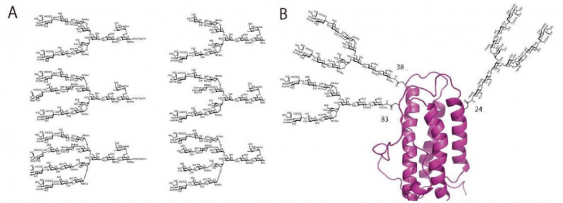Figure A: Diverse oligosaccharide structure.
Figure B: Structure of erythropoietin having three homogeneous oligosaccharides.
Glycoproteins prepared through precision chemistry, elucidating erythropoietin sugar chains
Dr. Masumi Murakami, Mr. Tsuto Kiuchi, assistant professor Dr. Ryo Okamoto, associate professor Dr. Masayuki Izumi and Professor Dr. Yasuhiro Kajihara in Organic biochemistry laboratory, Department of Chemistry, Osaka University and Ms. Mika Nishihara and Dr. Katsunari Tezuka in Glytech Inc. successfully synthesized five kinds of erythropoietin1 (EPO) derivatives by an organic synthetic approach and revealed the relationship between glycosylation2 pattern and EPO bioactivity.
A protein having oligosaccharides is classified as a glycoprotein and this glycoprotein has been used for biological drugs. EPO is a typical glycoprotein drug and has been used for the treatment of chronic anemia. The addition of oligosaccharides to a bioactive protein is essential in order to enhance bioactivity, but the function of oligosaccharide is still unclear.
Cell expression method3, that is a biotechnology, can produces glycoproteins, but their oligosaccharides structures are always heterogeneous. Because of this heterogeneity, we cannot understand in details which oligosaccharide structure is essential for glycoprotein bioactivity.
The Murakami group demonstrated EPO having three homogeneous oligosaccharides at the native three glycosylation positions determined by genetic code during molecular evolution, which showed the most potent biological activity. The Murakami group also demonstrated that oligosaccharides play an important role in covering hydrophobic protein surfaces4 in order to avoid hydrophobic protein-protein aggregation.
These research results will open a new research avenue not only to develop research on why glycosylation position was determined dependent on protein characteristic nature during the molecular evolution process but also to make potent as well as pure glycoprotein drugs in the future.
These research results have been published in Science Advances, 15 Jan 2016:

(Link) http://resou.osaka-u.ac.jp/en/research/2016/20160116_1









